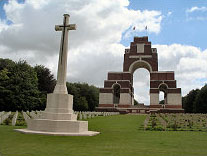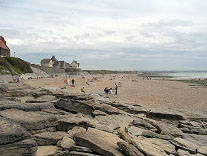What is becoming an annual pilgrimage to the Somme started after midnight on the 5th July. A few hours earlier I had given a talk about the Chorley Pals to St. Peter’s Mothers Union on Harpers Lane in Chorley (thanks for the donation, Ladies).
My wife and I caught an early ferry from Dover and headed for the Loos Memorial, less than an hour from Calais. On it is Chorley Pal, Pt. James Lancaster who survived the Somme but was killed by a sniper in October 1916 on the Loos battlefield. I also took the opportunity to look for the name of Capt. Vere de Hoghton on the memorial. He was related to the De Hoghton family from Hoghton Tower in Chorley, being killed in October 1915 attacking a German fortified position on the coalfields that make up the Loos battlefield. Interestingly his name is inscribed wrong, being spelt “De Houghton”.

Vimy Ridge Memorial
Lunch was taken at the recently renovated Canadian Memorial at Vimy Ridge. For the past two years it had been covered as contractors fought to save the monument from the ravages of the weather, high on the ridge the Canadians took in less than an hour in April 1917.

Thiepval Memorial
For a change we decided to stay in the town of St. Quentin, south east of the Somme battlefield. Friday morning saw us heading for the Somme, via Albert, to the Thiepval Memorial to the Missing on the Somme. On the monument are the names of 21 Chorley Pals who have no known grave, all being killed as they attacked the village of Serre on the morning of the 1st July 1916. However, I had another reason for visiting Thiepval this year.
A few months ago I was contacted by Dan Eaton from the village of Clayton near Bradford. He had, by the power of the Internet, seen the comment about my relative who was killed at Serre, next to the Chorley Pals, on the 1st July 1916. My Grandmother’s nephew, Private Benjamin Balme was from Clayton and he joined the 1st Bradford Pals in 1914, only to be killed like many other ‘Pals’ on the Somme in 1916. Dan Clayton sent me a photograph of my relative as well as some details about the Balme family. Benjamin Balme was just 21 when he was killed going over the top at Serre and has no know grave. I left a poppy close to his name on the Memorial, as well as an entry in the Memorial’s register to him and the Chorley men.
Coffee was taken, as always, at the Ulster Tower less than a mile along the British trench line from Thiepval. A warm Ulster welcome was forthcoming from the Tower’s custodians, Tommy and Phoebe, who have spent most of the last four years on the Somme battlefield. They said that the Rev. Ian Paisley was there a few days earlier for the commemoration and service on the 1st July.
Normally we would have headed for the Chorley Pals trenches at Serre but we took a slight diversion to Euston Road Cemetery, near Colincamps, just behind the British lines. The sun was shining but the wind was blowing over the exposed site as we paid respects to three Chorley Pals – Privates Blackstone, Clarkson and Hardman. All three were casualties of the attack on Serre on the 1st July.

Steve Williams lays a wreath by the Chorley Pals plaque in the trenches at Serre
The walk from the Serre Road to the Accrington Pals memorial and the small plaque to the Chorley Pals in the front line trenches crosses No Man’s Land – where so many Lancashire and Yorkshire men were cut to pieces by German machine guns on that ill-fated morning of July 1st, 1916. Out there, somewhere to my left, was my relative Private Balme; 21 Chorley Pals were keeping him company. A wreath was laid on the Chorley Pals plaque, kindly donated by the Pals Memorial Appeal Co-Founder, Chorley MP Lindsay Hoyle.
As always when I visit Serre I paid my respects to Lt. James Hitchon from my home village of Brindle who is buried in Queen’s Cemetery, a few yards into No Man’s Land. With him are five other Chorley Pals and many others from the 11th Bn. East Lancashire Regiment that perished that morning. We left the battlefield, pausing at Serre Road No. 3 Cemetery where Private Jack Hull from my neighbouring village of Whittle-le-Woods is buried along with another Chorley Pal, Private Clarence Widdop.

WW1 artillery shells
Just as we were returning to the car for our short journey to Arras, I noticed some WW1 artillery shells that the local farmer had recently dug up when ploughing the fields – “Iron Harvest” they call them!
We stayed in Arras for two nights, paying respects to Chorley Pals buried in Duisans British Cemetery and commemorated on the Arras Memorial. As always, John Garwood’s book about the Chorley Pals was consulted to help find the respective grave or panel.

Place de le Heroes from the top of Arras Town Hall
A pleasant Saturday afternoon was spent in Arras town centre visiting the underground tunnels that fan out from underneath the impressive Town Hall. A leisurely hour or so was also spent drinking coffee in the sunshine, watching numerous couples arrive to tie the knot at the building. They were accompanied by blaring horns and klaxons! – much to the amusement of three Gendarmarie (local Police) who were there to keep the traffic moving (rather than issue parking tickets).

Terlinchtun Memorial
On our way back to the ferry at Calais on Sunday, we visited two other Chorley Pals buried behind the lines. Pt. Thomas Gaskell is buried in St. Pol – after losing a leg at Serre on the 1st July, he succumbed to his injuries 18 days later. Just north of Boulogne is the Commonwealth War Graves Commission cemetery at Terlinchtun. Private Andrew McGrath, aged 24 from Chorley is interred here. After going through the war he caught a chill and died of pneumonia after the Armistice on the 21st November, 1918. On the hill overlooking the cemetery is an elevated statue to Napoleon (I understand that the Germans used it as target practice during the last War!).

Atlantic Wall at Audresselles
After a late lunch in the small seaside village of Audresselles, we drove along the coast to Calais glimpsing numerous reminders of the German ‘Atlantic Wall’ from the Second World War.
The journey back from Dover was arduous, stuck in long stretches of ‘road works’ on the M25, M1 and the M6 where lanes were closed “to protect the workforce” (who were not working on Sunday). How I wished those three Gendarmes from Arras had been around to keep the traffic moving!
At least we return home safely – unlike thousands of ‘Pals’ out on the Somme battlefield. As it says on the Chorley Pals plaque at Serre – “Where larks sing and poppies grow, they sleep in peace for evermore”.
Steve Williams
27.7.2007
Post Script: May I thank Chris Maguire, the Editor of the Chorley Guardian for publishing the story of my visit to Serre (above), and his continuing support for the Appeal.

